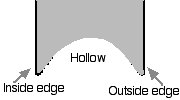Figure skating basics
When someone first starts learning how to figure skate, they don't immediately start with the flashy jumps and spins of freestyle, the wheels and blocks of synchro, the intricate movements of dance, or the lifts and throws of pairs. Every skater knows that before you go on to fancy stuff, it takes many years of mastering basic skills. It's not always glamorous. But for most people, it's still tons of fun. And it's never too late to start.
The Ice Skating Institute sets up its basic skating program with four beginner levels: Alpha, Beta, Gamma, and Delta. After a skater passes Delta, they then move on to freestyle. The United Skates Figure Skating Association has the BASIC program, which is similar to the ISI's introductory program. Skate Canada has learn-to-skate programs for figure skating, speed skating, and a program specially designed for those interested in synchro.
What is taught while learning the basic maneuvers are skills that a skater can take with them to any of the other branches of figure skating. The first thing new skaters usually learn is 1. how to fall and 2. how to get back up again. When you fall, it is important to try to land on your behind. When getting up again, the two positions to remember are "doggy, froggy." In "doggy," the skater has both knees and both hands on the ice. From there, he or she moves to "froggy," where, one at a time, each foot is moved forward, directly underneath the skater, much like the position of a seated frog. From the "froggy" position, it is much easier for a skater to get up.
Once skaters begin to advance, they learn how to use their edges. The bottom of a blade looks something like this:

The inside and an outside edges correspond with the inside and outside of the foot. If a skater is not completely over one edge or the other, this is considered skating on flats.
There are also many other skills a skater learns when they first start taking lessons or classes. All of these can be done on either foot, forwards or backwards.
- Two foot glides: gliding on two feet in a straight line
- One-foot glides: gliding on one foot in a straight line
- Swizzles/sculling/fishtails: A two-footed push achieved by bending your knees and pushing your feet apart to get momentum, and then bringing them together again.
- Pumps: Like above, except the push is done with one foot while the other foot remains stationary. This is mainly done for going around circles.
- Snowplow stops: a stop much like a ski stop
- Hockey stops: one-footed stop
- T-stops: Two footed stop where the free leg is placed either in front of or behind the skating leg
- Stroking: another "power move," where a skater pushes off onto one foot and glides.
- Dips or squats: A maneuver where the skater squats or "dips" down while bending their knees
- Crossovers: maneuver where one foot is crossed over the other. More advanced skaters will also be able to push the skating foot underneath the crossing foot in order to achieve more power.
- Lunges/drags: maneuver where the skater lunges forward with one leg and the other leg reaches behind and is dragged. (with back lunges, the "dragged" foot leads and the rest of the skater's body follows)
- Shoot-the-duck: a one-footed dip where the free foot is straightened and placed in front of the skater
- Three-turns: a one-footed turn which makes the shape of a 3 on the ice. A change of edge occurs at the point of the three, i.e. inside to outside, or outside to inside. (see turns)
- Mohawk turns: a two footed turn where each foot is on the same edge, i.e. outside to outside or inside to inside (see turns)
- Edge rolls: Gliding on one foot on a particular edge (outside or inside), thus making a half-circle on the ice.
"Basic" links
Ice Skating Institute
Recreational Figure Skating FAQ
Ice Skating for Beginners
"So You Wanna Learn the Basics?"
Back to Main Page
Email: hook-line-and-synchro@iceskater.co.uk